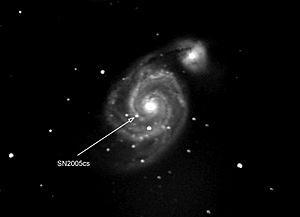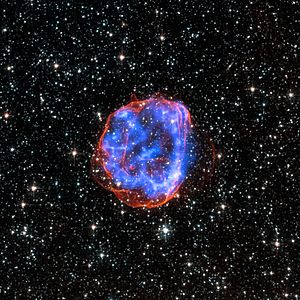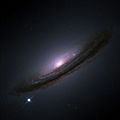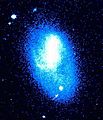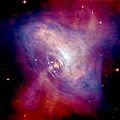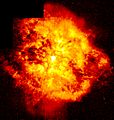Supernova facts for kids
A supernova is a giant explosion of a huge star. It happens when the star's core can no longer hold itself up against its own strong gravity. The core then collapses very quickly, causing a massive explosion.
The biggest exploding stars are called hypergiants, and slightly smaller ones are called supergiants. These stars are incredibly big! Because of their huge size and strong gravity, they use up their energy very fast. They usually only live for a few million years.
During a supernova explosion, the star shines brighter than an entire galaxy for a short time. It releases as much energy as our Sun will in its whole lifetime! The explosion blasts the star's material outwards at super high speeds, up to 30,000 kilometers per second. This creates a powerful shock wave that pushes into the gas and dust around the star. This expanding cloud of gas and dust is what we call a supernova remnant. After the explosion, what's left of the star can become a black hole or a neutron star.
Most stars, like our Sun, are too small to explode as supernovae. Instead, they slowly get colder and smaller, eventually becoming white dwarf stars.
Supernova explosions don't happen very often. In our own galaxy, the Milky Way, the last supernova we could see happened in the year 1604. But because there are so many other galaxies, astronomers see about 300 supernovae in them every year! Sometimes, these distant supernovae are even brighter than their entire home galaxy.
Contents
Types of Supernovae
Scientists usually put supernovae into two main groups: Type I and Type II supernovae.
Type I Supernovae
Type I supernovae don't show signs of hydrogen in their light. A special kind, called Type Ia supernovae, are very bright for a short time. Then they quickly fade away.
Type Ia supernovae happen when a white dwarf star is orbiting a bigger star. Sometimes, the white dwarf pulls material from its companion star. When the white dwarf gathers about 1.4 times the mass of our Sun, it suddenly collapses. This creates a huge amount of energy and light, making the supernova incredibly bright. Because Type Ia supernovae usually reach the same brightness, scientists use them like "standard candles" to measure how far away other galaxies are.
Type II Supernovae
Type II supernovae, on the other hand, do show signs of hydrogen in their light. For a star to have this type of explosion, it must be at least 8 times, but not more than 40 to 50 times, the mass of the Sun.
In a star like our Sun, nuclear fusion turns hydrogen into helium. In very large stars, this process continues, turning helium into oxygen, and so on. The star keeps fusing heavier and heavier elements until it forms a core of iron and nickel. Iron and nickel can't produce energy through fusion, so the fusion process stops. Without the outward push from fusion, the core collapses incredibly fast. This collapse creates a huge shock wave that blasts the rest of the star apart. The extreme heat and pressure during this brief moment also create elements heavier than iron. Depending on the star's original size, the leftover core becomes either a neutron star or a black hole.
Supernovae and Life
Without supernovae, there would be no life on Earth! This is because many of the important chemical elements we need were made in supernova explosions. These are called "heavy elements." Things like carbon, oxygen, and iron, which are essential for living things, were created this way.
Supernovae are the only way these heavy elements can be made. Other lighter elements are made by fusion inside stars. But heavy elements need extremely high temperatures and pressure to form. In a powerful supernova explosion, the temperature and pressure are so high that these heavy elements can be created. Scientists call this supernova nucleosynthesis.
It could be dangerous if a supernova exploded very close to Earth. The explosion is huge, and it creates many kinds of harmful radiation. But we don't need to worry! Only very big stars can explode as supernovae. There are no stars big enough near Earth that are about to explode. Even if there were, it would take millions of years for it to happen.
Important Supernovae We've Seen
- SN 1572 was seen by the astronomer Tycho Brahe. This supernova helped scientists understand that things in space could change.
- SN 1604 was seen by Johannes Kepler. It was the last supernova close enough to be seen from Earth's northern hemisphere without a telescope.
- SN 1987A is special because it was the only supernova close enough for scientists to detect tiny particles called neutrinos from it. SN 1987A was also bright enough to see without a telescope for people in the Southern Hemisphere.
Effects on Earth
Our Earth actually has tiny traces of past supernovae! Scientists have found traces of radioactive iron-60, which is a strong sign of supernova material, buried in the sea floor all over the world.
Our Solar System is surrounded by a large region of hot gas called the "local bubble," which is about 600 light years across. This bubble was formed by more than a dozen supernovae exploding in a nearby group of stars. This happened between 2.3 million and 1.5 million years ago. This time period roughly matches the beginning of the Pleistocene ice ages. It's possible there's a connection, but it might just be a coincidence.
Related pages
Images for kids
-
"A star set to explode", the SBW1 nebula surrounds a massive blue supergiant in the Carina Nebula.
-
SN 1994D (bright spot on the lower left), a Type Ia supernova out-shining its home galaxy NGC 4526 galaxy
-
SN 2008D, a Type Ib supernova, shown in X-ray (left) and visible light (right) at the far upper end of the galaxy
-
The pulsar in the Crab nebula is travelling at 375 km/s relative to the nebula.
-
Supernova remnant N 63A lies within a clumpy region of gas and dust in the Large Magellanic Cloud.
-
The nebula around Wolf–Rayet star WR124, which is located at a distance of about 21,000 light years.
See also
 In Spanish: Supernova para niños
In Spanish: Supernova para niños


